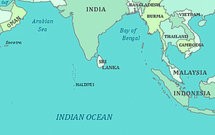 The Indian Ocean rim countries have establishment a number of multilateral maritime mechanisms to address non-traditional security threats and challenges confronting the region. The Indian Ocean Rim-Association of Regional Cooperation (IOR-ARC), rechristened as Indian Ocean Rim Association (IORA), is the only pan Indian Ocean economic grouping and brings together countries straddling three continents i.e. Africa, Asia and Australia. In recent times it has begun to address maritime security issues.
The Indian Ocean rim countries have establishment a number of multilateral maritime mechanisms to address non-traditional security threats and challenges confronting the region. The Indian Ocean Rim-Association of Regional Cooperation (IOR-ARC), rechristened as Indian Ocean Rim Association (IORA), is the only pan Indian Ocean economic grouping and brings together countries straddling three continents i.e. Africa, Asia and Australia. In recent times it has begun to address maritime security issues.
The Indian Ocean Naval Symposium (IONS) is a 35-member Indian Ocean security apparatus which facilitates exchange of views among the naval professionals to evolve common understanding of maritime security issues in the region. Likewise, Milan (confluence) is a gathering of navies from India’s extended neighbourhood of Southeast Asia, Australia and New Zealand that aims to develop cooperative mechanisms. The 2014 Milan at Port Blair in the Andaman & Nicobar Islands in the Bay of Bengal was significant from the perspective that 17 navies participated including two from Africa (Kenya and Tanzania), three Indian Ocean island nations (Mauritius, Maldives and Seychelles) and the navies of Philippines and Cambodia made their debut.
While IORA, IONS and Milan are successful models of maritime cooperation in their own right, they have shied from addressing hard security issues which appear in two forms; first, there is a gradual accretion of naval power by the Indian Ocean littorals; and second the continued presence of extra regional naval powers that are forward deployed in the Indian Ocean to support national strategic and economic interests. In essence, the Indian Ocean region emerges as an arena of cooperation and competition.
Among the Indian Ocean littorals, with over 140 vessels, the Indian Navy is the most powerful and its order of battle includes aircraft carriers, submarines, expeditionary platforms, long range maritime surveillance aircraft and these are supported by a sophisticated network centric capability including a dedicated military satellite. Like India, Australia is an important Indian Ocean power and is building its combat capabilities to include new submarines, air defence destroyers, fighter jets, and long range maritime patrol aircraft, etc. France has rejected the notion that it is an extra regional power in the Indian Ocean and its navy is forward deployed at Mayotte, Le Reunion, Djibouti and Abu Dhabi. Iran is an acknowledged regional military power in the Arabian Gulf and in recent times it has made forays deep into the Indian Ocean. Similarly, the Pakistan navy has an impressive array of air, surface and sub-surface capabilities, and has emerged into a powerful force.
Among the extra regional powers, the United States is the predominant military power in the Indian Ocean region and has several port access and basing agreements with Australia, Bahrain, India, Iraq, Kuwait, Oman, Pakistan, Qatar, Saudi Arabia, Singapore, Thailand, United Arab Emirates (UAE), Yemen etc. The US Navy has been the primary component of projecting US military power in the Indian Ocean. The British Royal Navy is forward deployed in the Indian Ocean in support of the US led operations and on account of the 1971 Five Powers Defence Arrangement (FPDA). The European Union is a new entrant in the Indian Ocean security dynamics and Operation Atlanta in the Gulf of Aden off Somalia to counter piracy which is its first ever naval operation.
Among the Asian powers, China’s engagements in the Indian Ocean is through its naval task force (CTF 525) and since 2008, it has deployed 25 warships in 10 groups. Japan is another major Asian power which has forward deployed its maritime and air forces in the Indian Ocean that operate out of its military facilities in Djibouti. Russia too is interested in the security dynamics of the Indian Ocean and the Russian navy’s show of ‘flag’ and ‘presence’ in the Indian Ocean reflects its ambition to engage in distant water operations. Likewise, the NATO has keenly observed the security dynamics in the Indian Ocean.
Although the Indian Ocean strategic milieu offers immense opportunities for maritime cooperation, the naval buildup by regional countries and the forward presence by extra regional powers showcase competitive dynamics. The US is the strategic anchor of the region and its presence is perceived both as coercive and also as a security provider. Interestingly, some regional countries have created legitimate space for the US naval presence in the Indian Ocean to correct security imbalances, challenge the hegemony of the dominant power and ensure regional stability. The US Navy conducts joint naval exercises and shares intelligence which assures the alliance partners of its political and diplomatic commitments. However, for some, the US is perceived as hegemonic reminiscent of the colonial period and adds to insecurity. Under the circumstances, it is important for IORA, IONS and Milan to also explore confidence building measures to preclude unwarranted naval standoffs.
By Special Arrangement with Institute of Peace and Conflict Studies (http://www.ipcs.org)